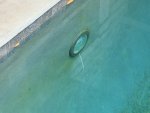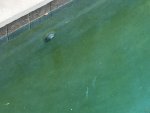I have several white lines running down my pool plaster which I think might be calcium deposits. I have attached a picture of one of the lines which starts at the bottom of my pool light and goes down several inches.
There is no white substance on the tile line.
Interestingly, my CH is a little low (180-200). I was getting ready to add some calcium chloride, but thought I should get a handle on these white lines first.
Can someone please help me confirm that these lines are, in fact, calcium and help me figure out what I should do about them? Thank you!
There is no white substance on the tile line.
Interestingly, my CH is a little low (180-200). I was getting ready to add some calcium chloride, but thought I should get a handle on these white lines first.
Can someone please help me confirm that these lines are, in fact, calcium and help me figure out what I should do about them? Thank you!



